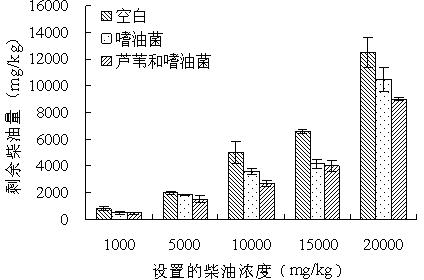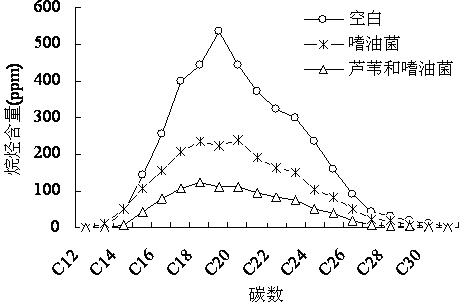Method for remediating petroleum contaminated wet land by combining Phragmites australis and microorganisms
A joint restoration and oil-based technology, applied in the field of plant-microbial joint restoration, can solve weak problems, achieve strong stress resistance, improve soil degradation and productivity decline, and simple operation
- Summary
- Abstract
- Description
- Claims
- Application Information
AI Technical Summary
Problems solved by technology
Method used
Image
Examples
Embodiment
[0019] Embodiment: Outdoor test of degreasing of reed and native oleophilic flora
[0020] This experiment was carried out in August 2009. The experimental site is on the open-air balcony on the fifth floor of the Environmental and Chemical Laboratory Building of Shanghai University. The institute is located in Baoshan District, Shanghai, which belongs to the humid zone and semi-humid continental monsoon climate, with an annual precipitation of about 500-600mm. The original oil-contaminated soil used in the test was taken from the Huangpu River-Yangtze River estuary wetland soil, and the three oilophilic strains used in this experiment were screened out from it. The clean soil was taken from the flower bed in the East District of Shanghai University. After passing through a 2mm sieve, it was evenly mixed with a sand-to-soil ratio of 2:3, and prepared into soil with different diesel concentration gradients. Configured into 5 concentration gradients, namely: 1000mg / kg, 5000mg / k...
PUM
 Login to View More
Login to View More Abstract
Description
Claims
Application Information
 Login to View More
Login to View More - R&D
- Intellectual Property
- Life Sciences
- Materials
- Tech Scout
- Unparalleled Data Quality
- Higher Quality Content
- 60% Fewer Hallucinations
Browse by: Latest US Patents, China's latest patents, Technical Efficacy Thesaurus, Application Domain, Technology Topic, Popular Technical Reports.
© 2025 PatSnap. All rights reserved.Legal|Privacy policy|Modern Slavery Act Transparency Statement|Sitemap|About US| Contact US: help@patsnap.com



